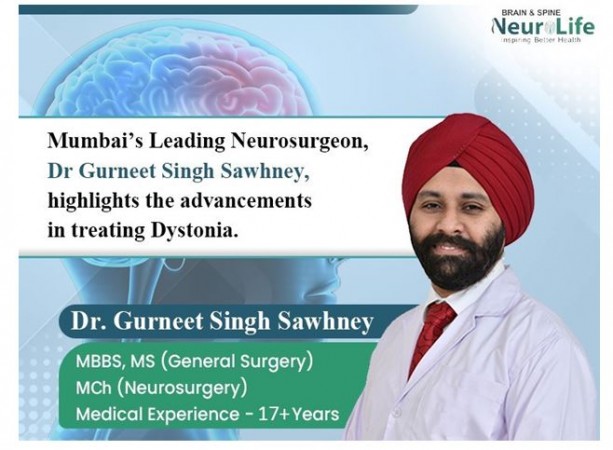
Dystonia is a complex neurological movement disorder that affects young children and adults. Patients with dystonia display involuntary muscle contractions in the face, vocal cords, arms, legs, and trunk and these movements are often repetitive postures and uncontrollable twists.
Dr Gurneet Singh Sawhne states, ‘Neurosurgeons focus on relieving the symptoms as there is no cure for dystonia. The current treatment protocol involves a multidisciplinary approach of medications, surgery and botulinum toxin (botox) injections. Recent treatment options include gene therapy and transcranial magnetic stimulation. Nevertheless, I am quite hopeful that both these options will be more comprehensive and effective in relieving the dystonia symptoms in patients.’
Dystonia, a neurologic movement disorder, can be acquired or inherited or idiopathic, i.e. with no specific cause. However, abnormal functioning of the basal ganglia, a deep part of the brain which helps control the coordination of movement, is the cause of dystonia. The function of the basal ganglia is to control the speed and fluidity of movement and prevent unwanted movements.
Patients with idiopathic dystonia do not show damage or degeneration to the brain. But on the other hand, the brains of patients with acquired dystonia show damage or degeneration because of stroke, brain injury or exposure to certain medications. And inherited dystonia is due to gene transfer.
Neurosurgeons pay extra attention to diagnose dystonia considering the similarity in symptoms, for instance, stress, stiff neck or a psychological disorder. In the initial stages, the patient will experience symptoms experiencing select tasks that affect the same body area or muscles in a repetitive order. Also, the intensity of the symptoms slowly indicates the disordered condition.
Patients with dystonia in the initial stages display increased blinking, excessive sensitivity to bright light and eye irritation known as Blepharospasm condition, while patients with oromandibular dystonia experience changes in speech cadence, difficulty chewing and subtle facial spasms. In addition, limb dystonia patients complain of fatigue during walking or physical activity and cramps in the hand while writing.
In 2001, Botulinum toxin type B was introduced to treat cervical dystonia. Also, Botulinum toxin type B has slightly mild side effects, which patients can manage. However, neurosurgeons recommend surgery if medications and other treatments are unsuccessful in relieving the symptoms of dystonia. Deep brain stimulation (DBS) is the main recommended surgery, followed by stereotactic thalamotomy, pallidotomy, and cervical rhizotomy depending upon the patient’s condition and likely side effects. At the same time, patients and their family members need to remember that these treatments relieve the patient of the symptoms but do not cure or treat dystonia.
Dr Gurneet Singh Sawhney narrates a case of a 32YO male patient who consulted him with complaints of abnormal movements in the neck, left shoulder,left hand and left leg, and husky speech. These abnormal movements were gradually increasing daily, and he could not perform his daily activities. He was diagnosed with generalized dystonia.
After thorough investigations and assessments, Dr Gurneet Singh Sawhney recommended a right-sided radio frequency lesioning operation, to which the patient agreed. Post surgery the patient recovered well. After 1 month of the surgery, the patient came for follow up along with his wifeand children to express his gratitude as he was leading a better life now.
About Dr Gurneet Singh Sawhney
Mumbai-based and highly dynamic neurosurgeon Dr Gurneet Singh Sawhney is considered one of the most competent neurosurgeons with an extensive experience of 17+ years. He has fellowships in Functional Neurosurgery (Japan), Fellowship in Epilepsy Surgery (Japan) and a Fellowship in Neuroendoscopy.
His expertise includes functional neurosurgery, peripheral neurosurgery, neuro-oncology, deep brain stimulation, spine surgery, neurocritical care, minimally invasive, image-guided neurosurgery, Intracranial Tumor Surgery, especially skull base tumors to name a few of them.
As a warm and emphatic doctor, Dr Gurneet Singh Sawhney makes patients feel comfortable and less anxious when interacting with him. Moreover, his multilinguistic capabilities also help in bridging the communication gap greatly.
Dr Gurneet Singh Sawhney is available for consultation at Neurolife Brain & Spine Clinic, Fortis Hospital Mulund, and Savla Diagnostic Center and Polyclinic, Chembur East.
For further details and appointments, call +91 8104310753 or email at gurneetsawhney@gmail.com.